“That’s a pretty wild and unkempt garden you have there. Did you lose control?” a visitor to my land once said. “Yes, I responded, it is wonderful.” When you look at pictures of gardens online, in gardening magazines, etc. things are very neat, tidy, and square. Everything is in a neat and tidy row, surrounded by beautiful paths, stonework, and flowers. Every single thing in that garden is just where the human intended it–no weeds, no stray plants, and no wildness. This idea of what makes a beautiful garden is culturally rooted–it is pristine, orderly, and full of flowers and vegetables to enjoy. Humans living in Western societies, certainly here in the US, have been socialized into seeing these kinds of gardens as the ideal. In the same way that a lawn with nice landscaping somehow “looks” more appealing than a wild meadow of flowers. But when we apply nature spirituality and animism to the equation, there are things about that perfectly square, neat, and tidy garden that don’t add up–and in this post, we’ll explore what it means to approach a gardening practice as an animist and interrogate some of these concepts.
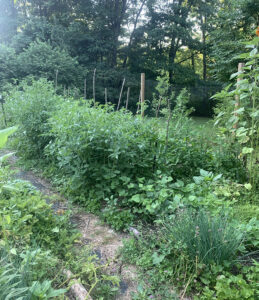
Today’s post will offer animistic gardening philosophy, where we interrogating dominant cultural approaches to gardening and create space for a more animistic perspective. In next week’s post, we’ll put the philosophy into practice with a set of suggested gardening activities that you can do. In my ongoing animism series, we’ve been exploring approaches to animism that allow us to inhabit, be, and experience the world of spirits around us. Previous posts in this series include an introduction to animism, co-creating intentions with nature, animism and permaculture introduction and ethics, connecting to the Genius Loci (spirit of place), and addressing waste. Today’s post will consider our overall relationship to the living earth through how we tend our land, tend our gardens, and grow food. If you haven’t read the previous posts, I would strongly suggest starting there, as this post builds from the previous ones.
A Cultural Challenge: Reframing Nature in Relationship to Humanity
Humans in the modern Western world have forgotten what it is like to inhabit the land and work with its rhythms and flows. This is part of why our world is so out of balance–because culturally, we’ve forgotten that we are part of nature too. A lot of us are working to right that balance, but it is very difficult to fight against the larger cultural currents where human dominion of nature is assumed to be the best path. As language deeply reflects culture, examining the language we use to even define such spaces can be helpful. Look at my friend’s three terms: wild, unkempt, and lose control to describe my garden–while he wasn’t saying this in a positive way, I responded in a way that did view the garden as a positive place. Here’s a list to start to show some of these
Qualities of western dominion of nature: orderly, neat, beautiful, tidy, mowed, well-maintained, domesticated
Qualities of a less human-dominated space: Wild, unkempt, eyesore, overgrown, out-of-control, weedy
We can see from this list really clearly what is desirable culturally–that is which is neat, tidy, and well maintained–and that creates beauty. But what about the garden that is more wild and undomesticated? And these lists really do reflect the larger cultural consciousness of the West that emphasizes the perfect lawn, the manicured landscaping, and the need to plant vegetables in orderly rows. All of these things stem from the West’s desire to dominate: nature, indigenous peoples, and everything that is not their own. And here in the US, things like manicured lawns also came out of a desire to replicate the grassy lawns maintained by the aristocracy in Brittain when one could afford a flock of sheep. If you are born in many places in the West, you’ll be socialized into this understanding–the landscape looks a certain orderly way, and perhaps you’ve never even really thought about those subconscious differences. (This, by the way, is a great example of Jung’s idea of the Collective Unconscious–you have thoughts and ideas embedded in you that are not yours but come to you by way of culture).
Understanding that these are some of the roots of the orderly garden can start to help us shift them, especially as we move into understanding gardens from an animistic lens.
The Foundation: Domestication, Wildness, Dominion, and Cultivation
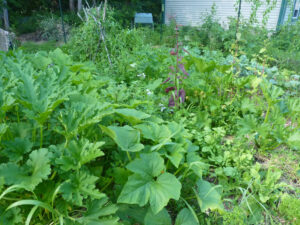
Animism is a belief in spirits–the spirits of the land, of stones, of rocks, of all of nature, as well as the things that derive from nature that people create (all of which have spirit). Animistic practice encourages building and maintaining relationships with these spirits, learning from them, and learning how to live in a right relationship with the world of spirit. See my post on Introduction to animism for more details about this practice.
That is, individuals who take up an animistic relationship with nature often find themselves having to re-think their overall relationship with nature on the most basic level. If the world is full of spirits, a garden we create also is full of spirit. How will we engage with those spirits? How will we respect them, while also working to address and overcome the deeply embedded cultural conditioning around humanity’s relationship with nature? There are two levels to this–rethinking your own practices but also thinking about how to articulate and even defend those practices to others who might still be carrying around problematic cultural baggage about nature. So now let’s look at a few categories that can help us understand the philosophy behind animistic gardening:
Domestication and Wildness: Domestication is when humans over generations and time seek to maintain control over the care, reproduction, and lives of other organisms for human gain (food, clothing, protection, etc). Domestication is why we have large tomatoes, corn, soybeans, and chickens, among many other plants and animals. Here in North America, you can see the difference in this between the wild turkey and the domestic turkey; both of which are the same species and all of which came from the same stock. Wild turkeys are extremely intelligent–as prey birds, they are very good at hiding, running away, and avoiding capture. They are lean with beautiful dark brown feathers that help them blend in with their surroundings. It is not easy to find them or track them–once they know you are around, they disappear into the woods. Compare this to domestic turkeys, who are fat, move slowly, cannot defend themselves, and are often bred with white feathers to stick out in a field–white feathers being harder to see on a finished carcass. Thus, human domestication has turned a wild and magnificent creature into a slow and overweight one that cannot live without human care. Domestication has created dependency.
Wild turkeys, and wild spaces, are just that–they are wild and free. They can grow however they want, do whatever they want, and the “agency” in deciding the direction of growth is up to the individuals growing in a specific context. Does the turkey want to go down by the stream or take a nap in the local meadow? The turkey decides. This freedom is terrifying to the western world, and hence, why we have so many negative connotations with “a garden gone wild.”
Part of the reason that the square, highly tended gardens with no weeds are culturally appealing is that they appeal as they are fully domesticated. They have no wildness left in them, and nearly everything in that space is designed by humans and for humans. Just like our domestic white turkey–bred for humans, without much care or thought about the will or desires of the turkey. And this is where we get back into the core ideals of colonialism and Western cultural biases: the Western World is obsessed with domestication. The more domesticated a space is, the more beautiful it is to the eye of someone who was raised in this culture. Both creating and maintaining that kind of space can be extremely harmful to the land and her ecosystem.
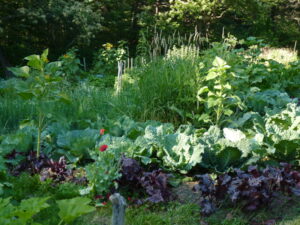
Cultivation and Dominion: So now that we have the broader issues addressed, we can consider how in gardening approaches apply fit in the above philosophy. Domestication of the natural world is dominion over nature. The goal here is where a human being seeks total control over nature and often uses the evils of society: fossil fuels and chemical poisons in order to achieve that goal. In this same domestication/dominion model, a garden whose sole purpose is to grow vegetables for a human being, and “weeds” are pulled or sprayed and insects are trapped, is an example. On the other hand, we have cultivation and tending, where a human being does work to shape a natural or outdoor space, but in a way that works with nature rather than against nature. No chemicals or sprays are used, and the goal is to create a healthy ecosystem where life can flourish. An example here would be an organic garden that contains a food forest. Parts of the garden may be more highly cultivated (the tomato patch) while others may be more wild (a pollenator hedge and orchard). A garden can certainly be tended and cultivated, but that doesn’t mean it needs to be human-dominated.
Another example here is lawn care: Lawn A is mowed once a week and kept very trim and tidy. A fire pit sits in the middle of the lawn. If too many dandelions pop up, they are either mowed or sprayed. The lawn serves the people who “own” it. Lawn B is of a similar size and is maintained for hosting events, fires, and gatherings. The lawn is grazed by a goose flock who have a rotating pasture system–they keep it mowed for a few weeks. The lawn is mowed once a month. The lawn grows whatever the lawn wants to grow–clover, dandelions, ground ivy, grass, all heal–and thus, also has medicine and food for many kinds of life. The humans who have this lawn purposefully spread dandelion seeds on the lawn because the greens are delicious for the flocks and humans.
We can see some really stark differences here in terms of cultivation vs. dominion in this example. Lawn A is in a human dominion and full domestication situation–the lawn must be a single monocrop of grass, it is mowed almost constantly and never allowed to grow more than 4″, and anything that wants to grow in the lawn that is not the grass is unwelcome. Lawn B has a very different vibe–animal rotational grazing helps keep the lawn low while also providing foraging for a homestead goose flock (who in turn, provide eggs and beautiful feathers as well as joy and friendship). Lawn B is mowed infrequently using an electric push mower–enough to address tick issues–and address anything the geese do not want to eat. Further, Lawn B is very diverse, growing ground ivy, clover, dandelion, speedwell, all-heal, grass, and many more plants. In the end, both spaces can host people and a fire, and can still serve the function intended by humans. But in the second space, the humans are tending and cultivating the lawn and allowing wildness to happen, rather than domineering it through fossil fuel.
So through these discussions of domestication/wildness and dominion/cultivation, we can have the foundation of an animstic philosophy of gardening, to which we now turn.
An Animistic Philosophy of Gardening
In my first post in the animism series, I spelled out a set of core principles for practicing animism. Three of them are as follows:
- Recognizing and honoring the spirits present in things present in the world and universe, both animate and inanimate, both natural and created
- Recognizing the importance of interacting in a respectful way with those spirits; building the right relationships and connections with them, and learning from them as teachers and guides
- Recognizing that our actions have a significant impact on others and that we can engage in right actions to behave in ways that honor the sovereignty of all being
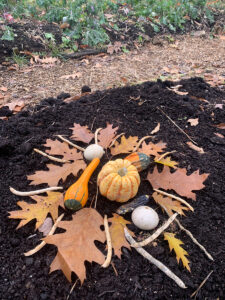
All three of these principles have a direct bearing on the decisions that someone who is both an animist and a gardener makes. It is obvious that dominion is not compatible with animism because in this case, the individual would not be in right relationship with the spirits of nature, nor would they be able to honor the sovereignty of those beings. But on the other hand, a person does want a garden–a cultivated space that can be used to grow food for a family, and bring joy, and beauty into one’s life. It’s ok to want a garden and it’s totally ok to cultivate a space for it. The key is in how you approach the initial creation of the space–what you do, how you do it, and how you work with nature along the way.
Here, cultivation or tending offers us a mid-point between wildness and dominion/domestication–it allows a relationship to form between self-determination and agency of nature (whatever wants to grow in the lawn can) with also cultivating it to still be useful to human beings. Remember that in previous eras, nearly all spaces were tended. This is one of the big takeaways from M. Kat Anderson’s Tending the Wilds book–for the native peoples of California, “wild” or “wilderness” had negative connotations because it meant it was land that nobody was tending. We see the same in Tyson Yunkaporta’s Sand Talk where he argues that humanity’s role is that of being stewards of nature. Thus, tending and cultivation as philosophies can help us find a balanced space between them. Thus, we can say that the definition of animsitic gardening is as follows:
Animistic Gardening is the practice of tending a plot of land for the purpose not only of growing food but also in creating sacred relationships with the spirits of nature.
- Seeking right relationship and balancing domesticated and wild spaces: Animistic gardeners seek the right relationship with the spirit world and world of nature, which includes balancing heavily tended with wild spaces and working with nature rather than against nature.
- Employing garden techniques to support a healthy ecosystem. Animistic gardeners and using gardening techniques that help foster a healthy soil web and ecosystem, which includes techniques that involve minimal soil web disruption, growing healthy soil, using a mixture of perennials and annuals, and creating features of the garden that create habitat, pollen, nectar, and other food sources for life.
- Reciprocating relationships. Special attention is paid to engaging in reciprocal relationships with the spirit world, honoring the sovereignty and wishes of the spirits of nature on the metaphysical world. In the physical world, attention is paid to providing gratitude and offerings for the bounty of nature and making sure you give as much as you recieve.
- Using organic and regenerative techniques. An animistic garden uses techniques that foster life and support the health of the ecosystem. This includes using no-till approaches, using integrated pest management and natural methods for addressing pests, working out develop healthy insect communities to address pest imbalances,
- Careful resource selection and use. Just as the animistic gardener seeks right relationship with the land where they garden, they also seek to engage in ethical resource use for any materials that are brought from outside, making sure these materials are either a) recycled/waste or b) harvested/obtained in an ethical manner that honors the spirits
Animistic spiritual development with gardening: A final thing I’ll share in this post is that developing animistic practices in relation to a garden is an outstanding way to develop a more deep and nuanced animistic practice. Animism isn’t just a spiritual or religious philosophy, it must be put into practice for you to really grow in that practice. Thus, the more ways that you are able to bridge the spiritual philosophy of animism with action in the world, the deeper and more meaningful your practice will become. Gardening is an outstanding way to develop our own animistic practice as it forces us to make clear decisions about the relationship between our beliefs, philosophies, and actions in the world.
Conclusion
Since this post has gotten pretty long, I’m going to save the gardening practices themselves for next week’s post, and follow up with some rituals and practices in part III. Thanks, as ever, for reading and blessings on your journey!
I also have a few announcements to share:)
First, the Ancient Order of Druids in America’s journal, Trilithon, is now available as a free PDF download or to purchase as a print copy. You can visit the AODA’s site for more information. Second, the AODA is still accepting submissions of rituals, poems, prayers, songs, and so forth forThe Druids Book of Songs, Ceremonies and Prayers, volume II. Please feel free to submit something to the book. Submissions will be accepted till January 1st, 2023. I serve as the editor and cover artist on both of these projects, and I also have two articles in the latest Trilithon!
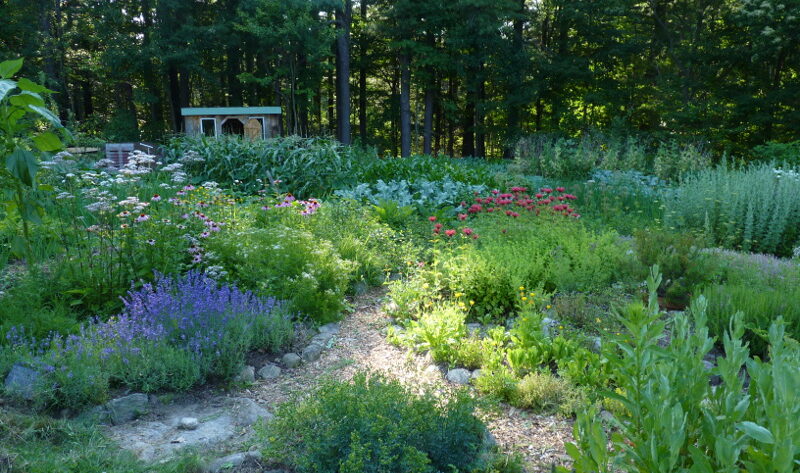



It’s why I don’t cut my hair or fight the grays that are outnumbering the chestnut! My hair (like my garden) is my flag of honoring my wildness of the feminine.
It is a magnificent garden and entirely eye appealing 🥰
Great post full of workable ideas. I offer one important challenge: Jung’s definition of the Collective Unconscious is different than yours: According to Jung, the collective unconscious is made up of a collection of knowledge and imagery that every person is BORN WITH and is SHARED BY ALL human beings due to ancestral experience. The archetype of a “garden” is rarely the gardens and lawns developed in the late 18th century. Why this is important is because recently Jungians proposed adding a “Cultural Complex” layer to the psyche structure. In a very real way the Collective Unconscious is our ally, and the Cultural Complex can be and has been hijacked by dominant figures/concepts; culture wars are one result. See: Don Kalsched (Culture Wars and the Hijacked Imagination) and Thomas Singer (Cultural Complexes and the Soul of America: A Way to Frame the Psychology of Polarization). It’s important to name your allies correctly, like your trees and “weeds”.
Hi Lola,
Thanks for sharing! I’ve read a bit about the cultural complex–thanks for sharing more.
I haven’t a clue why someone would ask if you lost control like your garden is a bad thing. The pics you’ve shared are absolutely beautiful & wild gardens are very popular. Wild gardens help our environment & our creatures & are the way nature intended. 🙂
I think that a lot of this has to do with how densely populated you are, or how expensive the houses are, etc. For example, in a lot of suburban neighborhoods, the idea of a wild garden would be never allowed because it would go against a homeowner’s association and/or affect neighborhood property values. Unfortunately, when I lived in the Detroit Metro area, I had more than one friend who had issues with their gardens, particularly those in front yards, being unruly, even illegal and having to remove them. Its a really big problem, at least here in the states.